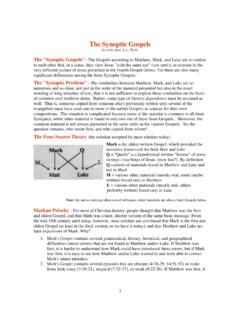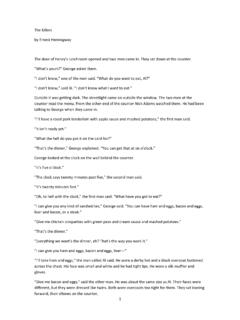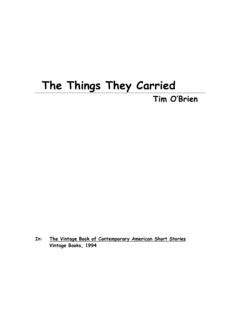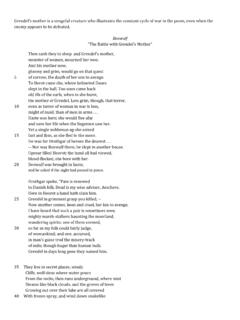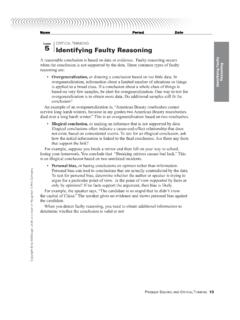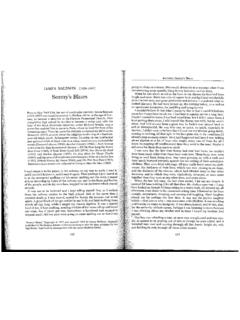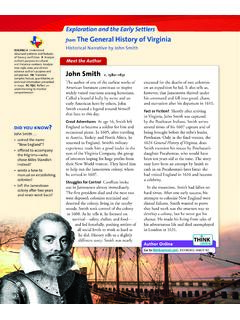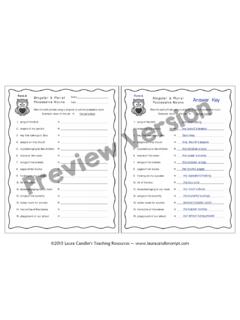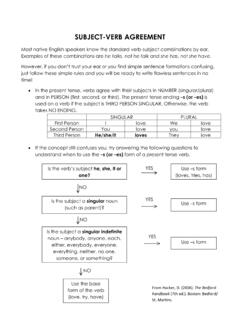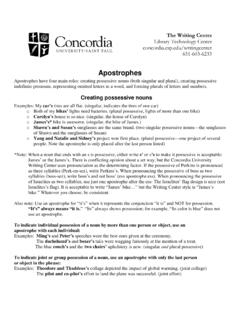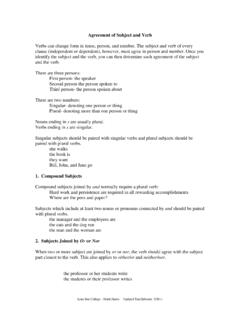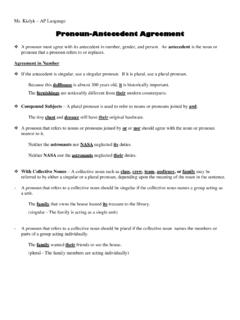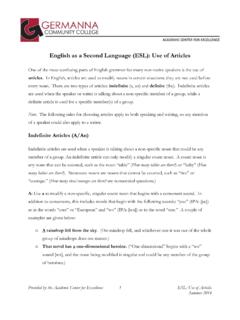Transcription of PACKET 6 SUBJECT VERB AGREEMENT - St. Francis …
1 PACKET 6. SUBJECT verb AGREEMENT . All nouns and pronouns have number. They are singular in number if they refer to one thing. They are plural in number if they refer to more than one thing. A. When a word refers to one person or thing, it is singular in number. When a word refers to more than one, it is plural in number. Examples: hat, I, sky, principle ( singular ). hats, we, skies, principles ( plural ). B. A verb agrees with its SUBJECT in number. Two words agree when they have the same number. The number of the verb must always agree with the number of its SUBJECT .
2 Examples: He fights. ( singular SUBJECT and singular verb ). Animals fight. ( plural SUBJECT and plural verb ). I. singular subjects take singular verbs. Examples: The lightning fills the sky. (The verb fills is singular to agree with the singular SUBJECT lightning.). Linda begins her vacation today. (The verb begins is singular to agree with the singular SUBJECT Linda.). II. plural subjects take plural verbs. Examples: Cheetahs run faster than most other animals. (The verb run is plural to agree with the plural SUBJECT cheetahs.)
3 New families move into our neighborhood frequently. (The verb move is plural to agree with the plural SUBJECT families.). ** Notice that an -s ending is often a sign of the singular in the verb . Examples: He screams. Everyone sings. NOTE - When a sentence contains a verb phrase, it is the helping verb that agrees with the SUBJECT . Examples: The motor is running. The motors are running. Examples: The girl has been sick. The girls have been sick. 1 PACKET 1/06 Disk ZZ (52). Hints for SUBJECT - verb AGREEMENT I.
4 (A) Cross out all prepositional phrases. Watch out especially for prepositional phrases beginning Examples: Every one of the students try/tries hard. with of or in. The windows in the house stick/sticks easily. (B) Cross out word groups within commas. Word groups between commas often begin with: as well as . Examples: The doctor, as well as the nurses, work/works hard. with . The girls, along with their dogs, walk/walks daily. along with . in addition to . (C) Cross out word groups beginning with and including.
5 Examples: Either the vase or the dish was/were a gift. Neither the teacher nor his students was/were here. II. Find the SUBJECT : (Remember, the SUBJECT cannot be one or the words that you crossed out in number I.). SUBJECT Examples: Every [one] of the students work/works hard. SUBJECT The [girls], along with their dogs walk/walks daily. SUBJECT Either the vase or the [dish] was/were a gift. III. Select the verb : (A) If the SUBJECT is singular , choose the verb ending in s.. singular SUBJECT , so Examples: Every one of the students try/tries hard.
6 Use verb with s . The doctor, as well as the nurses, work/works hard. (B) If the SUBJECT is plural , choose the verb ending without the s.. plural SUBJECT , so Examples: The windows in the house stick/sticks easily. use verb without s . The girls, along with their dogs, walk/walks daily. (C) If two subjects are joined by or or by nor, the verb usually agrees with the nearer SUBJECT . singular SUBJECT , so Examples: Either the vase or the dish was/were a gift. use verb with s . Neither the teacher nor his students was/were present.
7 plural SUBJECT , so use verb without s . HINT: Try substituting they ( plural pronoun), then use a plural verb (without s ). Try substituting he, she, or it ( singular pronouns), then use a singular verb (with s .). Doctor works Cat runs Windows stick (He) works (It) runs (They) stick 2 PACKET 1/06 Disk ZZ (52). Practice sentences: 1. One of the students ( is/are ) studying algebra. 2. The exhibit of the artist's paintings ( was/were ) very interesting. 3. Mrs. Andrews, along with, Mr. Stone, ( do/does ) volunteer work.
8 4. All of the salesmen, including Mr. Stone, ( was/were ) at the meeting. 5. Every one of the girls ( do/does ) her shorthand homework. 6. Either Julia or her friends ( is/are ) planning to attend. 7. Both of the carpenters ( is/are ) planning to do the job. 8. Neither the students nor the instructor ( want/wants ) to miss class. 9. The women, as well as the men ( sing/sings ) beautifully. 10. Most of the nurses ( work/works ) every day. V. (A) If a relative pronoun (WHO, WHICH, THAT, WHOSE) refers to only one, use a singular verb .
9 Examples: It is the only one of the stores that has / have shoes. This is the only one of the trees that bloom / blooms. (B) If a relative pronoun refers to a plural noun, use a plural verb . Examples: She is one of the best students who attend / attends. Example B: The prepositional phrase cannot be omitted; use the He is one of those persons who never grow / grows up. plural verb . 1. Read and complete all exercises in this PACKET . Refer to the HINT SHEET when needed. 2. Take the test for PACKET 6, 3 PACKET 1/06 Disk ZZ (52).
10 singular AND plural . SUBJECTS AND VERBS. Exercise 1: If a word is singular , write S before it. If it is plural , write P. _____ 1. morning _____ 11. mosquitoes _____ 2. calves _____ 12. actress _____ 3. women _____ 13 cave _____ 4. she _____ 14. we _____ 5. pencils _____ 15. leaves _____ 6. shelf _____ 16. chief _____ 7. they _____ 17. men _____ 8. heights _____ 18. babies _____ 9. geese _____ 19. Congress _____ 10. it _____ 20. mice Exercise 2: The subjects and verbs that follow are in AGREEMENT . If an item is singular , write S before it.
